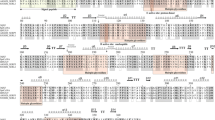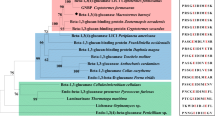Abstract.
An endo-β-1,4-glucanase (EG) was purified from the hindgut of an Australian mound-building termite, Coptotermes lacteus. The hindgut extract had a peak separate from those for extracts obtained from the salivary glands and the midgut based on sephacryl S-200 gel chromatography, and also demonstrated an origin different from the endogenous EGs of the termite itself. The recovery was further purified by SDS-PAGE, and its N-terminal amino acid sequence analyzed. This showed high homology to EGs from glycoside hydrolase family (GHF) 7. PCR-based cloning methods were applied to the hindgut contents of C. lacteus and individual protozoan symbionts from C. formosanus. cDNAs encoding putative EGs homologous to GHF7 members were then identified. The functionality of one of the putative proteins was confirmed by its expression in Escherichia coli.
Similar content being viewed by others
Author information
Authors and Affiliations
Additional information
Received 18 September 2002; accepted 20 September 2002
RID="*"
ID="*"Corresponding author.
Rights and permissions
About this article
Cite this article
Watanabe, H., Nakashima, K., Saito, H. et al. New endo-β-1,4-glucanases from the parabasalian symbionts, Pseudotrichonympha grassii and Holomastigotoides mirabile of Coptotermes termites. CMLS, Cell. Mol. Life Sci. 59, 1983–1992 (2002). https://doi.org/10.1007/PL00012520
Issue Date:
DOI: https://doi.org/10.1007/PL00012520




